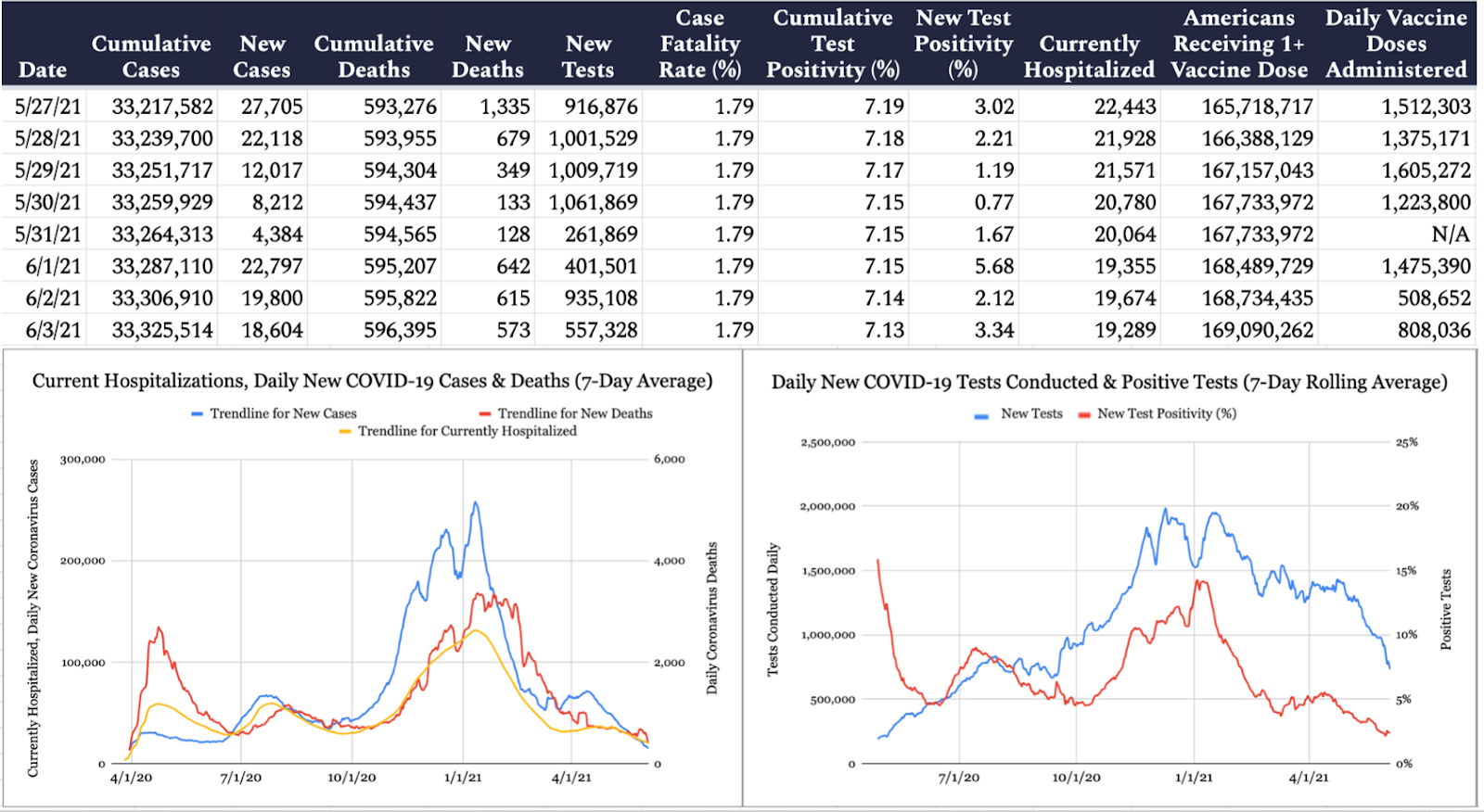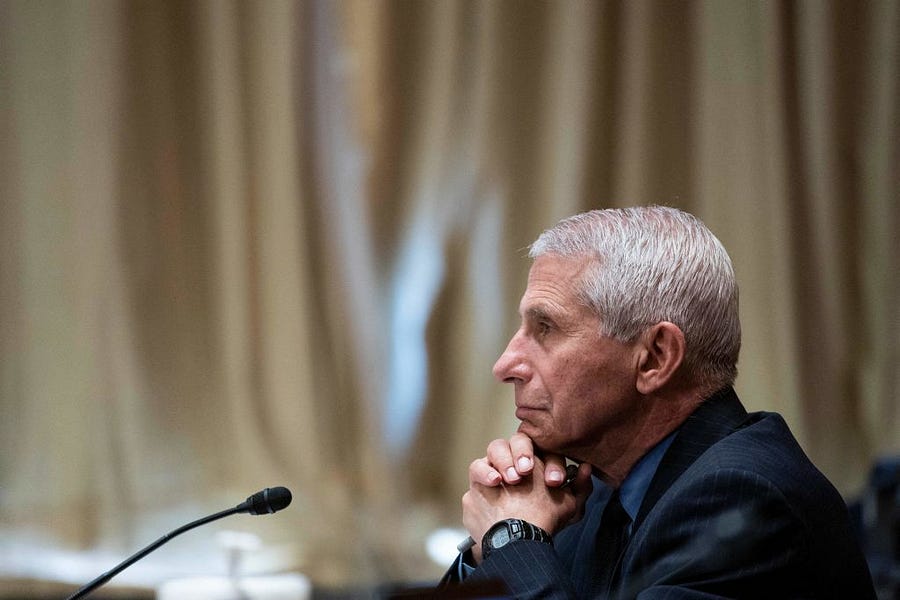Happy Friday! There are just a few hours until the Bureau of Labor Statistics releases its May report, and we can definitively say the economy added at least five jobs last month. Congrats to the Dispatch interns for finishing their first full week!
Quick Hits: Today’s Top Stories
The Biden administration announced on Thursday its allocation plans for the first 25 million COVID-19 vaccine doses the United States will share with other countries. Approximately 19 million will be distributed through COVAX—a global vaccination initiative spearheaded by the World Health Organization—and about 6 million will be sent to “regional priorities and partner recipients,” including Mexico, Canada, Ukraine, West Bank and Gaza, India, and Iraq.
The White House issued a warning to U.S. businesses on Thursday following a series of ransomware attacks, urging them to take “immediate steps” to protect themselves from hackers. The memo, from Deputy National Security Adviser for Cyber and Emerging Technology Anne Neuberger, stressed that “no company is safe from being targeted by ransomware, regardless of size or location.”
President Joe Biden issued an executive order on Thursday prohibiting Americans from investing in Chinese firms that are linked to the Chinese military or surveillance technology. The order lists 59 Chinese firms, expanding upon a similar order issued by former President Donald Trump in November that listed 31 firms.
Initial jobless claims decreased by 20,000 week-over-week to 385,000 last week, the Labor Department reported on Thursday, the lowest level since March 14, 2020.
The United States confirmed 18,604 new cases of COVID-19 yesterday per the Johns Hopkins University COVID-19 Dashboard, with 3.3 percent of the 557,328 tests reported coming back positive. An additional 573 deaths were attributed to the virus on Thursday, bringing the pandemic’s American death toll to 596,395. According to the Centers for Disease Control, 19,289 Americans are currently hospitalized with COVID-19. Meanwhile, 808,036 COVID-19 vaccine doses were administered yesterday, with 169,090,262 Americans having now received at least one dose.

How Experts and Officials Suppressed the Lab-Leak Theory
As new COVID cases continue to plummet and the vaccines make their way slowly but surely across the land, it’s starting to look like the scientific and geopolitical debate over the pandemic’s origins may hang around longer than the pandemic itself. Scientists remain divided as to whether the likeliest explanation is that the coronavirus simply jumped naturally from animals to humans—a mechanism known as “zoonotic spillover”—or whether the first COVID-causing viruses might have escaped from a lab studying bat coronaviruses in Wuhan, China.
Solving these sorts of viral whodunnits is never easy, and investigators have been dealt a particularly hard hand in this case. The Chinese government spent months aggressively trying to bury any and all investigations into the question, and the international team they did eventually let in earlier this year was significantly limited in the scope of its inquiry. But it’s also becoming clear that China’s attempt to bury the lab leak theory got a significant assist from institutions on this side of the Pacific as well.
Part of the problem was simple media mistakes. Conspiracy theories claiming the virus had been deliberately developed and released as a Chinese bioweapon were rampant online at the onset of the pandemic, and many pundits conflated any discussion of the lab’s potential role in the infection chain with those wild tales. Others, like the Washington Post, rejected questions about the potential lab-leak scenario as “debunked” conspiracy theories early on, even though the origins of the virus were (and still are) uncertain.
But new reporting this week suggests that experts inside the government were unduly hostile to the lab-leak theory as well—some seemingly for the same reason they had mentally associated it with conspiracies; others for sketchier reasons.
On Tuesday, several outlets published a trove of emails sent and received last year by Dr. Anthony Fauci, the nation’s top infectious-disease expert, which they obtained through a Freedom of Information Act request. The emails don’t contain much about the lab-leak theory, but they do suggest Fauci fell prey to some of the same thinking that was ubiquitous in left-leaning media coverage at the time. One exchange between Fauci and National Institutes of Health Director Francis Collins concerns a report about the lab-leak possibility from Fox News’ Bret Baier, with the subject line, “conspiracy gains momentum.” Nearly all of what Collins and Fauci said about the report is redacted in the publicly released documents.
A more significant revelation, however, came in an exhaustively reported piece in Vanity Fair on Thursday. Opposition to the lab-leak theory, reporter Katherine Eban wrote, didn’t just come from people wrongly convinced it was a conspiracy theory. It also came from people within the U.S. government who knew that research into making viruses more infectious was going on at the Wuhan lab. That lab had received hundreds of thousands of dollars from National Institutes of Health grants to study bat coronaviruses in recent years. Some government officials were anxious to keep those facts from entering the COVID-origin discourse:
In an internal memo obtained by Vanity Fair, Thomas DiNanno, former acting assistant secretary of the State Department’s Bureau of Arms Control, Verification, and Compliance, wrote that staff from two bureaus, his own and the Bureau of International Security and Nonproliferation, “warned” leaders within his bureau “not to pursue an investigation into the origin of COVID-19” because it would “‘open a can of worms’ if it continued.”
More:
A small group within the State Department’s Arms Control, Verification, and Compliance bureau had been studying the Institute for months. The group had recently acquired classified intelligence suggesting that three WIV researchers conducting gain-of-function experiments on coronavirus samples had fallen ill in the autumn of 2019, before the COVID-19 outbreak was known to have started.
As officials at the meeting [in December 2020] discussed what they could share with the public, they were advised by Christopher Park, the director of the State Department’s Biological Policy Staff in the Bureau of International Security and Nonproliferation, not to say anything that would point to the U.S. government’s own role in gain-of-function research, according to documentation of the meeting obtained by Vanity Fair.
Last week, President Biden announced he had ordered the intelligence community to prepare “a report on their most up-to-date analysis of the origins of COVID-19, including whether it emerged from human contact with an infected animal or from a laboratory accident.”
“Here is their current position,” Biden said. “While two elements in the IC lean toward the [human contact with an infected animal] scenario and one leans more toward the [laboratory accident]—each with low or moderate confidence—the majority of elements do not believe there is sufficient information to assess one to be more likely than the other.”
Biden added he had asked the intelligence community to prepare a definitive report on its current understanding of the question within 90 days.
Fauci, who has in recent months acknowledged the possibility of a lab leak, fretted in an MSNBC interview Thursday that too much U.S. scrutiny of the scenario could lead to China pulling back further.
“Obviously you want openness and cooperation,” Fauci said. “One of the ways you can get it is, don’t be accusatory. … I think the accusatory part about it is only going to get them to pull back even more. We’ve got to do it in a combination of diplomacy, scientific, forensic investigation, and do it in a way that the people of good faith—not who want to do blame, but people in good faith—are really trying to find out what the origin is.”
Ransomware Attacks on the Rise
Since we first wrote about the Colonial Pipeline hack last month, several more high-profile ransomware attacks have impacted the United States. This week, JBS, the largest meat processor in the world, shut down some of its operations after an attack by a Russia-based cybercrime syndicate known as REvil. REvil is known to have ties to DarkSide, the group that hacked Colonial Pipeline, and both groups offer “ransomware as a service,” frequently leasing their software to other criminals.
Other recent victims of ransomware attacks—which use software to extort victims by infiltrating networks and threatening to lock, delete, or expose data unless a ransom payment is made—include the Japanese conglomerate Fujifilm and a ferry service in Massachusetts. The New York Times reported this week that New York’s Metropolitan Transit Authority was hacked in April by a group believed to be linked to the Chinese government, although services were not disrupted.
Ransomware attacks have been growing in prevalence for about half a decade. “Because ransoms have been paid previously, and because we haven’t successfully deterred this type of attack, it’s become a really profitable business model,” Klon Kitchen, a national security and cyber expert at American Enterprise Institute, told The Dispatch. “More and more people are getting into the game.”
An April 2021 report from the Institute of Security and Technology found nearly 2,400 governments, health care facilities, and schools in the United States were victims of ransomware attacks in 2020 alone. Those victims made a combined $350 million in ransom payments—a 311 percent increase from 2019—and businesses that were targeted took an average of 287 business days to fully recover.
As the Colonial Pipeline hack revealed last month, these attacks have the potential to grind multibillion-dollar businesses to a halt for days on end. And bad actors are just getting started. “The effects of ransomware will be felt more and more by everyone as operators become more brazen and aggressive,” John Hultquist, vice president of analysis for Mandiant Threat Intelligence at the cybersecurity company FireEye, told The Dispatch. “The supply chains, logistics, and transportation that keep our society moving are especially vulnerable to ransomware, where attacks on chokepoints can have outsized effects and encourage hasty payments.”
The events of the past few weeks have raised questions over where the responsibility of preventing ransomware attacks—particularly foreign ones—ultimately lies: With the government, or individual companies?
The White House is trying to split the difference. “These are private sector entities who have a responsibility to put in place measures to protect their own cybersecurity,” Press Secretary Jen Psaki said Wednesday when asked why this trend has seemed to surge since President Biden took office. But she added that the administration is “working closely with the private sector” to find best practices in combating the threat.
That partnership took a step forward yesterday, when deputy national security adviser Anne Neuberger sent a memo to business leaders warning them about the dangers ransomware attacks pose and providing guidance for how to best prepare for them. “Business executives should immediately convene their leadership teams to discuss the ransomware threat and review corporate security posture and business continuity plans to ensure you have the ability to continue or quickly restore operation,” she wrote, running step-by-step through a list of precautionary measures businesses should take.
Neuberger’s memo builds on an executive order Biden signed following the Colonial Pipeline hack aimed at modernizing federal agencies’ and some federal contractors’ cybersecurity efforts.
Kitchen described the Biden administration’s actions thus far as “normal good governance,” but emphasized the need to do more.
“To really go after this, we need to get a lot tougher,” he said. “U.S. intelligence and military enterprises should specifically be tasked to identify, deter, disrupt, and dismantle foreign ransomware attacks, attackers, and their networks. These attacks should be treated as cyberterrorism, and any nation state that enables or harbors those attackers should be engaged accordingly.” (Just hours after our interview with Kitchen, Reuters reported that “the U.S. Department of Justice is elevating investigations of ransomware attacks to a similar priority as terrorism.”)
“What we have to do is make these attacks so costly and painful for the bad guys that they decide the rewards aren’t worth it,” Kitchen continued. “And specifically, we have to change the political calculus of government leaders like [Russian President Vladimir] Putin.”
While the recent surge in ransomware attacks is not solely the work of Russian actors, Kitchen said that hacking syndicates “could not operate with the impunity that they have absent tacit support from the Russian government.”
Psaki told reporters Thursday she expects cybersecurity to be a topic of discussion at Biden’s summit with Putin in Switzerland set for later this month. “The President’s message will be that responsible states do not harbor ransomware criminals, and responsible countries must take decisive action against these ransomware networks,” she said.
Kitchen argued the president “absolutely should” bring up the topic, but that he must be willing to back up his words with actions.
“It’s time for the United States to start putting some of these ransomware operatives’ heads on spikes,” he said. “We’ve got to demonstrate that we are very serious about this, and that we will not allow the nation to be held hostage this way.”
Worth Your Time
Major League Baseball celebrated its inaugural Lou Gehrig Day earlier this week, which aims to raise awareness of the fight against amyotrophic lateral sclerosis (ALS), the disease that took the Yankee slugger’s life 80 years ago. In a piece for ESPN, Jeff Passan tells the story of Bryan Wayne Galentine, the baseball fan whose ALS diagnosis inspired him to make Lou Gehrig Day a reality. “Major League Baseball was a monolith. Galentine didn’t care; he always needed something to scale,” Passan writes. “He had given his family everything he could. What he wanted to leave behind now was for everyone already acquainted with the malevolence of ALS—and everyone else, who may not understand but would if Bryan Wayne Galentine had anything to say about it.”
Josh Barro proposed a solution to our growing ransomware problem in a piece for Business Insider yesterday: Make it illegal for businesses hit with an attack to pay the ransom. “If your company has been attacked, you might have good reason to pay a ransom. Paying the ransom may allow you to get your business back online faster than if you tried to rebuild your systems without hackers' assistance. Time is money, and a faster restoration means fewer angry customers and less apparent, immediate effect on the US economy from the attack on you,” he writes. “But ransom payments also create negative externalities. Ransom payments finance the groups that commit these attacks, and they encourage them to make more attacks. When you pay a ransom, it hurts everybody else, by making future attacks more likely.”
The New York Times’ Maggie Haberman reported earlier this week that former President Trump “has been telling a number of people he’s in contact with that he expects he will get reinstated [to the presidency] by August.” It isn’t just Haberman—National Review’s Charlie Cooke is hearing the same thing. “I can attest, from speaking to an array of different sources, that Donald Trump does indeed believe quite genuinely that he—along with former senators David Perdue and Martha McSally—will be ‘reinstated’ to office this summer after ‘audits’ of the 2020 elections in Arizona, Georgia, and a handful of other states have been completed,” he writes. “The scale of Trump’s delusion is quite startling. This is not merely an eccentric interpretation of the facts or an interesting foible, nor is it an irrelevant example of anguished post-presidency chatter. It is a rejection of reality, a rejection of law, and, ultimately, a rejection of the entire system of American government. There is no Reinstatement Clause within the United States Constitution. Hell, there is nothing even approximating a Reinstatement Clause within the United States Constitution.”
Presented Without Comment
Toeing the Company Line
On yesterday’s Advisory Opinions, Sarah and David discuss Van Buren v. United States, how the meaning of the word “so” is at the center of a Supreme Court case involving a corrupt cop, an FBI sting operation, and a confidential government database. Plus: A discussion about a free speech controversy at Stanford Law School, and thoughts on a 6th Circuit ruling striking down racial prioritization for COVID relief loans.
Chris Stirewalt continues his 2020 election autopsy for the Republican Party in the latest episode of The Hangover. This week, he’s joined by his AEI colleague Matthew Continetti to discuss the ascendance of populism within the GOP, understanding “constitutional conservatism,” and the demography of the electorate.
University at Albany scholar Shawn Bushway dropped by The Remnant this week to chat with Jonah about all things crime. Is the broken windows theory on its way out? Has America made any real progress on race? And why are Democrats still talking about defunding the police?
On the site today: Jonah writes about supporting the Afghan interpreters and allies who supported U.S. and coalition forces in our time there, and Emma has a piece looking at the Texas GOP’s election law.
Let Us Know
Have you been listening to Chris Stirewalt’s Hangover podcast? What are your thoughts? And do you have any ideas for additional limited-run style podcasts we should do?
Reporting by Declan Garvey (@declanpgarvey), Andrew Egger (@EggerDC), Haley Byrd Wilt (@byrdinator), Audrey Fahlberg (@FahlOutBerg), Charlotte Lawson (@charlotteUVA), Ryan Brown (@RyanP_Brown), Harvest Prude (@HarvestPrude), Tripp Grebe (@tripper_grebe), Emma Rogers (@emw_96), Price St. Clair (@PriceStClair1), Jonathan Chew, and Steve Hayes (@stephenfhayes).






Please note that we at The Dispatch hold ourselves, our work, and our commenters to a higher standard than other places on the internet. We welcome comments that foster genuine debate or discussion—including comments critical of us or our work—but responses that include ad hominem attacks on fellow Dispatch members or are intended to stoke fear and anger may be moderated.
With your membership, you only have the ability to comment on The Morning Dispatch articles. Consider upgrading to join the conversation everywhere.